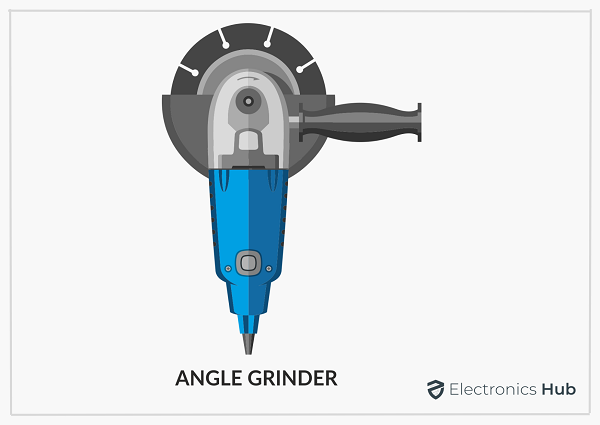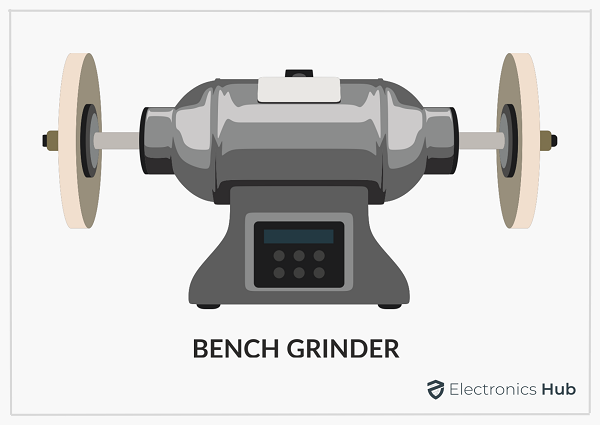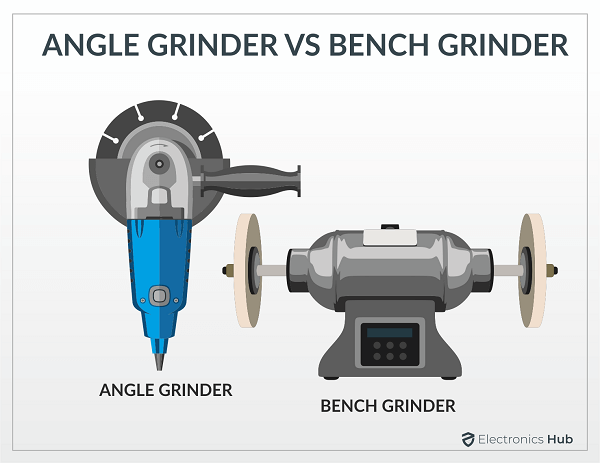When working on any kind of renovation project, the angle grinder is essential in order to achieve aggressive polishing or abrasive cutting. But, there is also an option for a bench grinder that employs better abrasive wheels which can sharpen tools and shape metals before you carry on with your welding project.
Both are useful for certain purposes and can be used effectively to achieve your goal. There is constant confusion as to which one is perfectly suited to your requirements. In this article, we will discuss both options that will help you choose better.
Outline
ToggleWhat is an Angle Grinder?

The tool is available in corded and cordless versions and is a constant feature in worksites and several shops. It is highly popular due to the versatility offered by interchangeable discs.
How Does an Angle Grinder Work?
This tool uses a small air compression system or motor employed to drive a gear head, along with a spindle. Several angle grinder discs can be fastened and attached to the spindle by tightening the screw. When the power is turned on, the attached disc with the gear head rotates rapidly and is then applied to the material for polishing, grinding, or abrasive cutting.
What is a Bench Grinder?

Usually, they are a lot less versatile tools than the former, and also they are not as portable.
How Does a Bench Grinder Work?
The bench grinder is set on a stationary bench top and has a working principle similar to the angle grinder without cutting abilities. It is generally used for polishing several materials, sanding, and grinding. The most common design is the gear head located centrally with a motor and two adjacent wheels attached.
When the power is on, the motor charges the two wheels, and the work can be carried out by applying the tool to the material. Similar to the angle grinder, the wheels can be altered depending on the user’s requirements.
Comparison Between Angle Grinder and Bench Grinder

| Factor | Angle Grinder | Bench Grinder |
| Working Principle | Powered by a motor and works with rotary discs. | Powered by a motor and works with rotary wheels. |
| Portability | Portable | Stationary |
| Uses | Paint and rust removal, weld clean-up, cutting bar stock, screws, rebar, sanding, polishing, and grinding. | Sanding, polishing, chamfering and deburring, sharpening drill bits, lathe tool sharpening and grinding. |
| Versatility | More versatile | Less versatile |
| Power Source | Air compressors, electric, rechargeable batteries. | Electric. |
| Price | 20$-300$ | 50$-800$ |
| Vibrations | More vibrations | Fewer vibrations |
| Wheel Speed | Faster wheels | Slower wheels |
| Number of Wheels | 1 | 2 |
| Flexibility | More Flexibility | Less Flexibility |
| Weight | 7-8 lbs | More than 55 lbs |
| Design | Handheld | Control pieces to grind |
| Accuracy | User dependent | User dependent |
1. Working Principle
The working principle for both tools is similar but not the same. An angle grinder is a handheld tool with different angled discs which rotate rapidly and are applied to the working materials. On the other hand, a bench grinder is a stationary tool featuring two abrasive wheels which rotate rapidly and are then applied to work materials.
You must be careful about safety and prevent any injury from the flying debris in the grinder guard. The grinder guard is placed right behind the gear disc or head.
2. Portability
The angle grinder is among the most portable power tools. They are usually powered by air compression or electricity and hence restricted with the freedom of moving around the location of the air compression or electrical output. It also depends on the length of the air hose or electrical lead on hand.
However, the advanced angle grinder is powered by a rechargeable battery but for those, the power output and the lifespan of the machine are reduced. So, it is better with a direct power source.
On the contrary, a bench grinder is a stationary tool, implying it cannot be moved. They are attached to a heavy stand or bench and carrying it around is difficult. However, the tool is not very heavy and can be moved with a little manpower.
3. Uses
There are several uses for an angle grinder on materials like plastics, concrete, ceramics, wood, and metal. It is used for the following purposes:
- Paint and rust removal
- Weld clean-up
- Cutting bar stocks, screws, and rebar
- Sanding
- Polishing
- Grinding
The bench grinder cannot be used for such extensive functions as the angle grinder, but they make up for it with efficiency. The bench grinder can also work on plastics, concrete, ceramics, wood, and metal. Its general uses are listed below:
- Sanding
- Polishing
- Chamfering and deburring
- Sharpening drill bits
- Lathe tool sharpening
- Grinding
4. Versatility
Angle grinders are highly flexible and can be applied to several metals of different sizes. It can be used in various fields of work like metalworking, concreting work, woodworking, etc. The disc can also be changed according to the size of the material. The interchangeable discs are the game-changer. They can perform high levels of sanding, grinding, and cutting. For instance, one of the most popular flap discs is not a grinding wheel but can efficiently remove material. It can also be used for carving and woodworking.
On the other hand, bench grinders restrict their usability and focus on certain tasks. But, there are several grinding wheels in the market with variable functions, thickness, and coarseness, which accommodate applications like sanding and polishing.
5. Power Source
Another distinct difference between the tools is the power source that drives the tools. The angle grinder is powered by one of the following methods. They are:
- Air compressors for the pneumatic angle grinders,
- Electric power for the corded angle grinders, and
- Rechargeable batteries for the cordless angle grinders.
On the flip side, the bench grinders are generally powered through electrical power outlets.
6. Price
The angle grinders are budget-friendly, and the lowest model can be purchased for 20 dollars only. The cost is influenced by the brand, kind of power source, and size. For a high-quality angle grinder, the price ranges from 80 dollars to 300 dollars.
While the bench grinders start at 50 dollars for light-duty tasks. But, the ones with more power and a higher lifespan start from 200 dollars and can range up to 800 to thousand dollars.
7. Vibrations
When working with both tools, it is likely that you will feel a little vibration owing to their speed and power. But the important thing is that the angle grinder shows a lot more vibrations than the bench grinder.
As the bench grinder is stationary on a flat surface, the weight of the tool and the surface reduces the vibrations to keep it to a minimum. Now, as the angle grinder is a handheld tool, the vibrations are more and it is less stable.
8. Wheel Speed
When speed is concerned, the angle grinder is much faster than the bench grinder.
So, it is suggested to go for the angle grinder if you want your tool to be easy to move and portable. It is highly suitable for fast jobs. The small cutting jobs can be done faster and finished within minutes. The bench grinder is not so fast but more accurate.
9. Number of Wheels
The bench grinder features two wheels that can be used simultaneously and attached at the same time. On the contrary, the bench grinder has one wheel at a time.
This is not a significant distinction as it saves time in switching to a different disc while using the angle grinder.
10. Flexibility
As the angle grinder is a portable, handheld tool, it has more uses, and applications and is suitable for many jobs when compared to the bench grinder. As the bench grinder is fixed, you have to move around it for the job to be done.
Owing to the different angles, the angle grinder is useful for a variety of applications. However, the bench grinder is less flexible and can only handle certain tasks.
11. Weight
The weight of the angle grinder is much lower than the bench grinder. This enables the user to carry the tool easily. The average weight of the bench grinder is around 7 to 8 lbs.
But, the bench grinder has a cast-iron base, making it heavy. So, the bench grinder is stationary and has lesser vibrations.
12. Design
The angle grinder is designed to fit in your hand and has a long handle for easy functioning. It is also kept in mind to reduce the vibrations.
While the design of the bench grinder is better when it features a long awkward to control the pieces to grind.
13. Accuracy
This is a tricky one as the accuracy for both tools depends majorly on the user. It takes a little practice to make everything right for each tool. Neither of them is accurate if the user cannot use them properly.
Which One Should I Buy, an Angle Grinder or an Bench Grinder?
There is no direct answer to this question as it depends on a lot of factors. We have mapped a clear route below for you to reach the answer, which is the suitable tool according to your requirements.
The angle grinders are suitable for the following.
- If portability is a concern then an angle grinder is the right choice.
- The home-based or industrial cutting of materials, polishing, sanding, and grinding project of yours needs flexibility, accuracy, and manual control, then go for the angle grinder.
- If you want to work both indoors and outdoors and with or without the electric output, then go for this tool.
- If versatility is a lookout at an affordable price range, then an angle grinder is the one for you.
The bench grinder is suitable for the following.
- Efficient or fast sharpening of materials, sanding and grinding in a given location for residential and industrial use is achieved easily with the bench grinders.
- If you are working on projects needing repetition and production-line efficiency, use this tool.
- Where the tasks demand the user to be hands-free, then a bench grinder is more suitable.
Final Word
Both the angle grinder and the bench grinder are highly useful tools that can be used for several different tasks. For absolute flexibility, both these tools are favourable but if you are on a budget, then you should go for the one which is more suitable for the tasks that you have in hand.
We have tried to solve all doubts regarding the angle grinder and the bench grinder but if you still have queries do mention them in the comments section below.

